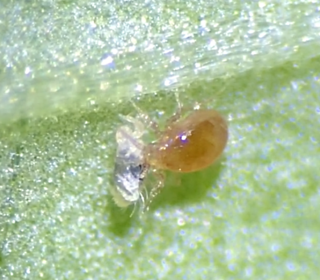
The Phytoseiidae are a family of mites which feed on thrips and other mite species. They are often used as a biological control agent for managing mite pests. Because of their usefulness as biological control agents, interest in phytoseiids has steadily increased over the past century. In 1950, there were 34 known species. Today, there are 2,731 documented species.
The Amblyseiinae are a subfamily of mites in the Phytoseiidae family.
Typhlodrominae is a subfamily of mites in the Phytoseiidae family.
Amblyseiulella is a genus of mites in the Phytoseiidae family.
Archeosetus is a genus of mites in the Phytoseiidae family.
Asperoseius is a genus of mites in the Phytoseiidae family.
Chelaseius is a genus of mites in the Phytoseiidae family.
Indoseiulus is a genus of mites in the Phytoseiidae family.
Iphiseiodes is a genus of mites in the Phytoseiidae family.
Kampimodromus is a genus of mites in the Phytoseiidae family.
Macroseius is a genus of mites in the Phytoseiidae family.
Neoparaphytoseius is a genus of mites in the Phytoseiidae family.
Okiseius is a genus of mites in the Phytoseiidae family.
Olpiseius is a genus of mites in the Phytoseiidae family.
Paraamblyseius is a genus of mites in the Phytoseiidae family.
Paragigagnathus is a genus of mites in the Phytoseiidae family.
Paraphytoseius is a genus of mites in the Phytoseiidae family.
Amblyseius alpinia is a species of mite in the Phytoseiidae family. It is endemic to Taiwan.
Amblyseius ankaratrae is a species of mite in the Phytoseiidae family. It was described by Blomners in 1976.
Amblyseius bellatulus is a species of mite in the Phytoseiidae family that is native to Taiwan. It was described by Tseng Yi-Hsiung in 1983. Following his retirement, Tseng's collection of more than 20 holotypes of Taiwanese phytoseiid fauna were lost. A. Bellatulus re-described in 2017 by a team from National Taiwan University led by Liao Jhih-Rong, who collected new specimens of phytoseiid mites from the original locale used by Tseng as well as other areas throughout Taiwan.

